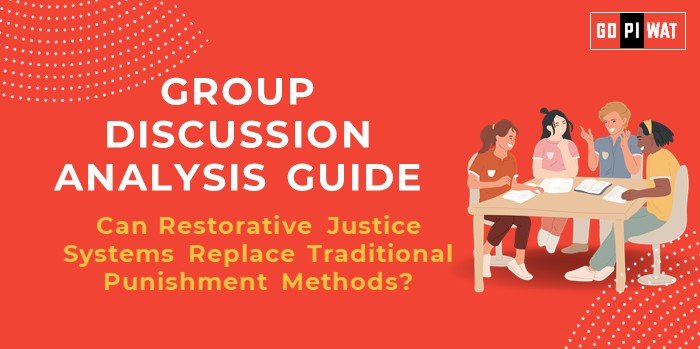📋 Group Discussion (GD) Analysis Guide: Can Restorative Justice Systems Replace Traditional Punishment Methods?
🌐 Introduction to the Topic
- 💬 Opening Context: Globally, the justice system is undergoing transformation, with restorative justice gaining prominence as a progressive alternative to punitive measures. This approach emphasizes rehabilitation over retribution, aiming to heal both offenders and victims while reducing recidivism.
- 📜 Topic Background: Restorative justice originated in indigenous practices, where reconciliation was prioritized over punishment. Modern iterations began in the 1970s and have since been adopted in countries like New Zealand and Norway. In India, experiments in restorative justice are emerging in juvenile cases and community conflicts.
📊 Quick Facts and Key Statistics
- 📉 Recidivism Reduction: Countries implementing restorative justice, like Norway, report recidivism rates below 20%, compared to over 50% in punitive systems.
- ✔️ Victim Satisfaction: Studies reveal that 85% of victims participating in restorative justice feel their needs were met.
- 🌍 Global Adoption: Over 100 countries include restorative practices in their justice systems.
- 🇮🇳 India’s Progress: Pilot programs in restorative justice are currently being tested in Delhi’s juvenile courts.
🔍 Stakeholders and Their Roles
- 🏛️ Government: Facilitates policies for integrating restorative justice into existing systems.
- ⚖️ Judiciary: Oversees its application while ensuring fair trials.
- 🤝 NGOs: Mediate restorative sessions and support victims/offenders.
- 👥 Citizens: Participate in restorative practices to ensure societal healing.
🏆 Achievements and Challenges
Achievements:
- 🤝 Community Healing: Effective in resolving conflicts in culturally diverse communities.
- 💸 Reduced Costs: Restorative justice often costs less than incarceration.
- ✔️ Reintegration Success: Focus on offender rehabilitation ensures social reintegration.
Challenges:
- ❌ Resistance to Change: Societal and institutional preference for punitive systems.
- ⚖️ Complex Cases: Difficult to apply in cases involving severe crimes like murder.
- 💔 Victim Reluctance: Emotional barriers to confronting offenders.
Global Comparisons:
- 🇳🇴 Norway: Focuses on offender rehabilitation in open prisons.
- 🇳🇿 New Zealand: Incorporates restorative justice in youth courts with high success rates.
Case Studies:
- 🇮🇳 India: Restorative practices in Delhi juvenile courts have reduced detention periods.
🎯 Structured Arguments for Discussion
- ✅ Supporting Stance: “Restorative justice reduces recidivism by prioritizing rehabilitation over punishment.”
- ⚖️ Opposing Stance: “Certain crimes require deterrent punishment, which restorative justice may fail to provide.”
- 🤝 Balanced Perspective: “Restorative justice can complement traditional systems, ensuring fairness and rehabilitation.”
🗣️ Effective Discussion Approaches
- 📜 Opening Approaches:
- “Countries like Norway report recidivism rates below 20% in restorative systems—highlighting their success.”
- “Restorative justice emphasizes rehabilitation, aligning with modern trends in justice reform.”
- 🔄 Counter-Argument Handling:
- “While serious crimes need deterrents, restorative justice works well for non-violent offenses.”
- “Restorative systems can complement traditional methods, offering a balanced approach to justice.”
🔍 Strategic Analysis of Strengths and Weaknesses
- 💪 Strengths: Reduces reoffending, improves victim satisfaction, and lowers costs.
- 🔧 Weaknesses: Limited applicability in severe crimes, resistance from traditionalists.
- 🌟 Opportunities: Potential for integration with technology in mediation.
- ⚠️ Threats: Risk of misuse and lack of awareness.
💼 Connecting with B-School Applications
Real-World Applications: Insights for projects on public policy, legal technology, and social welfare.
Sample Interview Questions:
- 💡 “How can restorative justice improve the legal system?”
- 💡 “What are its limitations compared to punitive approaches?”
Insights for Students:
- Emphasis on societal impact and conflict resolution skills.
- Understanding the role of empathy in leadership and policy design.


